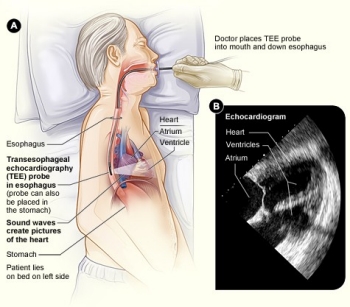Transesophageal Echocardiogram ( Tee ), Transesophageal Echocardiogram (Tee)
Our electrophysiologists and other heart doctors go through a comprehensive diagnostic process to help guide our treatment planning for all types of heart conditions. Transesophageal echocardiography (TEE) is an ultrasound technology that provides highly detailed images of the heart and its internal structures.
Đang xem: Tee
Our heart experts use TEE to detect blood clots, evaluate heart valves, and guide treatment for arrhythmias (abnormal heartbeats) and many other heart conditions.
Specialized expertise of our imaging technologists in producing highly detailed images of the heart using TEE, and of our doctors in interpreting the results.
Ease of access to the echocardiography lab, adjacent to the Arrhythmia Service clinic, for all your care in one convenient location.
If you are a new patient and want to request and appointment or need help finding a doctor, please call 650-723-6459, Option 3.
If you are a returning patient, call 650-723-6459, Option 2, to request an appointment.

A transesophageal echocardiogram (TEE) is an imaging test that uses sound waves to produce high-quality, moving pictures of the heart. An echocardiogram (echo) shows the size and shape of the heart and details of the heart’s internal structures.
Xem thêm: khách sạn meriton nha trang
For a TEE, an imaging technologist guides the transducer (sonogram device in the shape of a thin, flexible tube) into your mouth and down your esophagus to obtain the images. You will take medication to help you relax and to numb your throat so that you will not feel discomfort during the procedure.
Because your heart is just in front of the esophagus, a TEE provides clearer, more detailed images of the left chambers of the heart than a standard echo, which we perform on the surface of your chest. Learn more about echocardiography at Stanford.
We use TEE to:
Assess how well the heart’s chambers, valves, and blood vessels are working, for proper blood flow through the heartCheck for structural abnormalities in heart valves and chamber wallsGuide the positioning of catheters in many diagnostic and treatment procedures
circles
false
What to Expect
Transesophageal echocardiography is usually recommended when very specific part of the heart needs to be imaged with greater resolution. It allows us to see better definition of structures within the heart, and it can be especially helpful for identifying clots or infections.
Before a transesophageal echocardiogram (TEE), the following steps should be observed:
The doctor will explain the procedure and offer the opportunity to ask any questions about the procedurePatients will be asked to sign a consent form that gives permission to do the test. Read the form carefully and ask questions if something is not clearFasting prior to the procedure is required. The doctor will notify patients how long to fast, whether for a few hours or overnightIf patients are pregnant or suspect they may be pregnant, patients should notify their doctorNotify the doctor if patients are allergic to or sensitive to medications, local anesthesia, or latexNotify the doctor of all medications (prescription and over-the-counter) and herbal supplements patients are takingNotify the doctor if patients have a history of bleeding disorders or if they are taking any anticoagulant (blood-thinning) medications, aspirin, or other medications that affect blood clotting. It may be necessary to stop some of these medications prior to the procedureThe doctor may request a blood test prior to the procedure to determine how long it takes the blood to clot. Other blood tests may be done as wellNotify the doctor if patients have heart valve disease, a congenital heart condition, or a history of endocarditis (infection of the heart valves) as patients may need to receive an antibiotic prior to the procedurePatients may receive a sedative prior to the procedure to help with relaxation. If a sedative is given, patients will need to arrange transportation after the procedure
Based upon certain medical conditions, the doctor may request other specific preparations.
Xem thêm: metrang
A transesophageal echocardiogram is performed by inserting a probe with a transducer down the esophagus rather than placing the transducer on the chest.
Generally, a TEE follows this process:
Patients will be asked to remove any jewelry or other objects that may interfere with the procedure. If patients wear dentures or any oral prosthesis, they will be removed prior to the insertion of the TEE probeIf patients are asked to remove clothing, patients will be given a gown to wear.Patients will be asked to empty their bladder prior to the procedureAn intravenous (IV) line will be started in the hand or arm prior to the procedure for injection of medication and to administer IV fluids, if neededPatients will lie on a table or bed, positioned on their left side. A pillow or wedge may be placed behind the back for supportPatients will be connected to an ECG monitor that records the electrical activity of the heart and monitors the heart during the procedure using small, adhesive electrodes. Vital signs (heart rate, blood pressure, breathing rate, and oxygenation level) will be monitored during the procedureA local anesthetic spray will be applied to the back of the throat. This will numb the back of the throat to make passing the TEE probe more comfortablePatients will receive a sedative medication in IV before the procedure to help with relaxationIf indicated, oxygen will be administered through nasal tubesThe room will be darkened so that the images on the echocardiogram monitor can be viewed by the doctorThe TEE probe will be passed through the mouth and down the throat. Patients may be asked to swallow to help pass the probeOnce the probe is in the right place, the images will be obtainedAfter the necessary images are obtained, the probe will be removed from the throat
After the esophageal echocardiogram, the following procedures and notes should be observed:
Patients will be moved to a recovery area, where nurses will monitor the patient”s heart rate, ECG, blood pressure, and oxygen levelsWhen gag reflex has returned, vital signs are stable, and patients are more alert, the ECG electrode pads, the oxygen probe, and the IV will be removed and patients can get dressedPatients may feel weak, tired, or groggy for the remainder of the day of the procedure. Patients should feel normal by the day after the procedure. The throat may be sore for a few days following the procedure due to the insertion of the TEE probe.If the procedure was performed on an outpatient basis, patients may be discharged home, unless the doctor determines that the condition requires further observation or hospital admission.If patients received sedation, they will need to have someone drive them home.Patients may resume their usual diet and activities unless the doctor advises differently.Generally, there is no special type of care following a TEE. However, the doctor may give patients additional or alternate instructions after the procedure, depending on the needs
Before a transesophageal echocardiogram (TEE), the following steps should be observed:
The doctor will explain the procedure and offer the opportunity to ask any questions about the procedurePatients will be asked to sign a consent form that gives permission to do the test. Read the form carefully and ask questions if something is not clearFasting prior to the procedure is required. The doctor will notify patients how long to fast, whether for a few hours or overnightIf patients are pregnant or suspect they may be pregnant, patients should notify their doctorNotify the doctor if patients are allergic to or sensitive to medications, local anesthesia, or latexNotify the doctor of all medications (prescription and over-the-counter) and herbal supplements patients are takingNotify the doctor if patients have a history of bleeding disorders or if they are taking any anticoagulant (blood-thinning) medications, aspirin, or other medications that affect blood clotting. It may be necessary to stop some of these medications prior to the procedureThe doctor may request a blood test prior to the procedure to determine how long it takes the blood to clot. Other blood tests may be done as wellNotify the doctor if patients have heart valve disease, a congenital heart condition, or a history of endocarditis (infection of the heart valves) as patients may need to receive an antibiotic prior to the procedurePatients may receive a sedative prior to the procedure to help with relaxation. If a sedative is given, patients will need to arrange transportation after the procedure
Based upon certain medical conditions, the doctor may request other specific preparations.
close Before
During
During the Procedure
A transesophageal echocardiogram is performed by inserting a probe with a transducer down the esophagus rather than placing the transducer on the chest.
Generally, a TEE follows this process:
Patients will be asked to remove any jewelry or other objects that may interfere with the procedure. If patients wear dentures or any oral prosthesis, they will be removed prior to the insertion of the TEE probeIf patients are asked to remove clothing, patients will be given a gown to wear.Patients will be asked to empty their bladder prior to the procedureAn intravenous (IV) line will be started in the hand or arm prior to the procedure for injection of medication and to administer IV fluids, if neededPatients will lie on a table or bed, positioned on their left side. A pillow or wedge may be placed behind the back for supportPatients will be connected to an ECG monitor that records the electrical activity of the heart and monitors the heart during the procedure using small, adhesive electrodes. Vital signs (heart rate, blood pressure, breathing rate, and oxygenation level) will be monitored during the procedureA local anesthetic spray will be applied to the back of the throat. This will numb the back of the throat to make passing the TEE probe more comfortablePatients will receive a sedative medication in IV before the procedure to help with relaxationIf indicated, oxygen will be administered through nasal tubesThe room will be darkened so that the images on the echocardiogram monitor can be viewed by the doctorThe TEE probe will be passed through the mouth and down the throat. Patients may be asked to swallow to help pass the probeOnce the probe is in the right place, the images will be obtainedAfter the necessary images are obtained, the probe will be removed from the throat
close During
After
After the Procedure
After the esophageal echocardiogram, the following procedures and notes should be observed:
Patients will be moved to a recovery area, where nurses will monitor the patient”s heart rate, ECG, blood pressure, and oxygen levelsWhen gag reflex has returned, vital signs are stable, and patients are more alert, the ECG electrode pads, the oxygen probe, and the IV will be removed and patients can get dressedPatients may feel weak, tired, or groggy for the remainder of the day of the procedure. Patients should feel normal by the day after the procedure. The throat may be sore for a few days following the procedure due to the insertion of the TEE probe.If the procedure was performed on an outpatient basis, patients may be discharged home, unless the doctor determines that the condition requires further observation or hospital admission.If patients received sedation, they will need to have someone drive them home.Patients may resume their usual diet and activities unless the doctor advises differently.Generally, there is no special type of care following a TEE. However, the doctor may give patients additional or alternate instructions after the procedure, depending on the needs






Bình luận